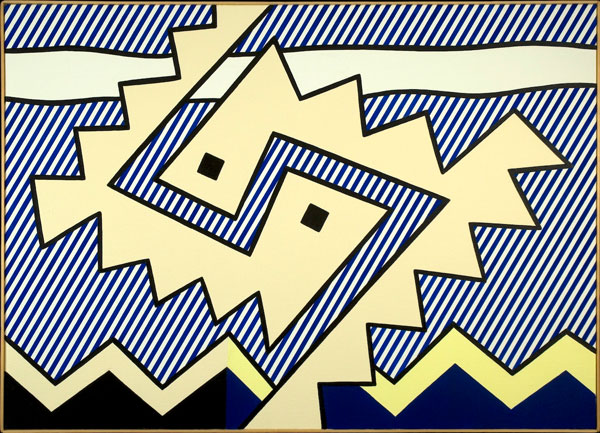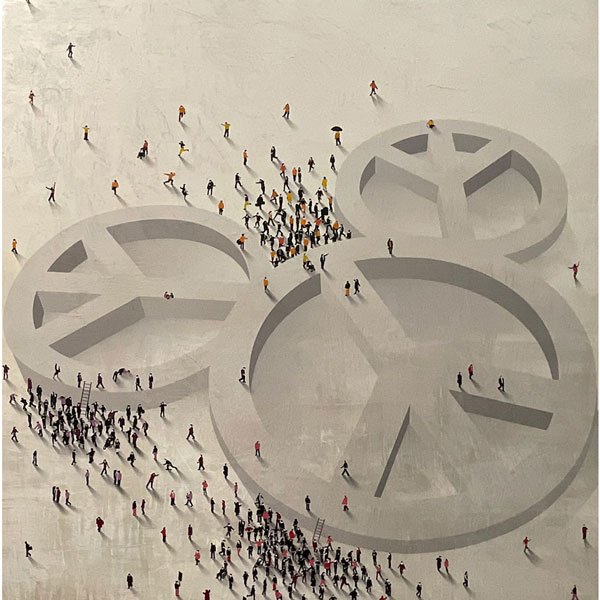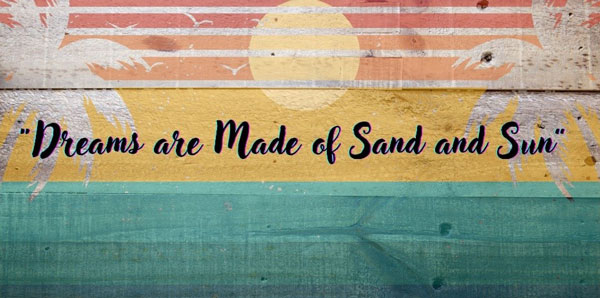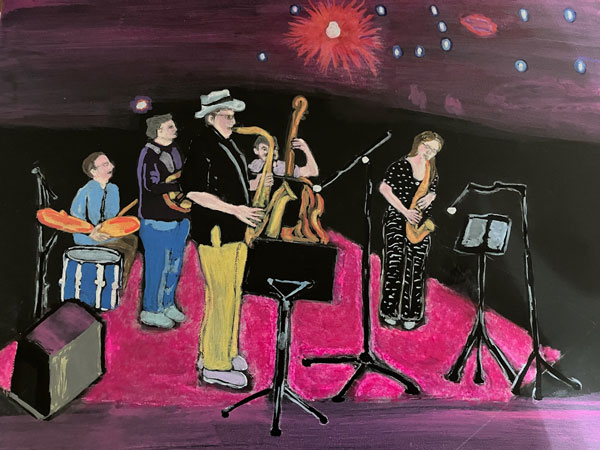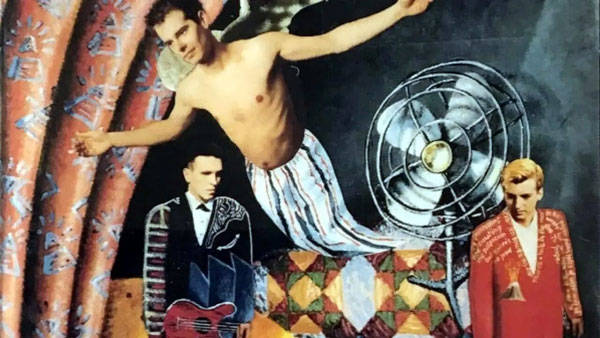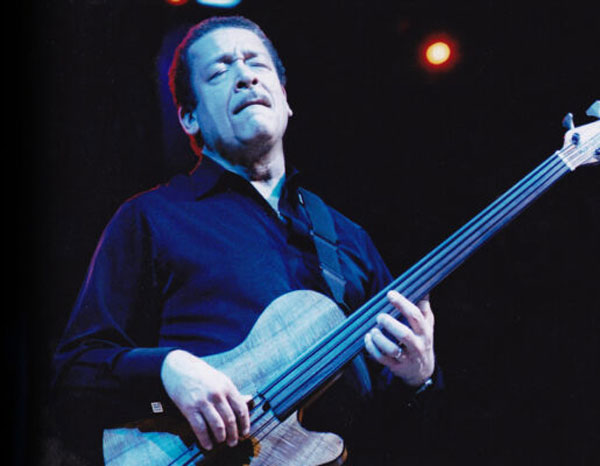By Ilene Dube, JerseyArts.com
originally published: 03/24/2023

Above photo: Alison Saar, ‘Cotton,” from the series Topsy Turvy, 2018. Wood, copper, ceiling tin, bronze, tar, and vintage found tools; 142. 2 × 58.4 × 101.6 cm. (Photo courtesy of L.A. Louver, Venice, CA); Alison Saar, “Jitterbug,” 2019. Multi-block linocut; 49.5 × 45.7cm, 58.4 × 54.6 cm (frame). (Photo courtesy of L.A. Louver, Venice, CA)
Hair. It seems a trivial topic to lead off with when discussing two of the most accomplished, influential women in literature and the arts. And yet you can’t ignore the references to the reclamation of Black female identity through hair in the artwork of Alison Saar.
In the exhibition, “Cycle of Creativity: Alison Saar and the Toni Morrison Papers,” on view at the Princeton University Art Museum’s Art@Bainbridge galleries through July 9, several works depict young women with hair rising up, in braids and strands, ending in white cotton bolls.
The works are from Saar’s “Topsy Turvy” series. Topsy was a character in the classic anti-slavery novel “Uncle Tom’s Cabin” written by abolitionist Harriet Beecher Stowe in 1852 – the book is believed to have helped lay the groundwork for the Civil War. Topsy, an abused child who arrives at the home of her enslavers in nothing but a gunny sack, was perceived by her captors as a wild child in need of taming.
In Saar’s depictions – a sculpture made from wood, metal, ceiling tin, tar and vintage tools; a linocut on hand-dyed found sugar sacks; and a color woodcut – the young women carry tools of the slave crops: a bale hook, sickles, axes, knives, and a clothes iron dripping with blood. They will not be tamed. They are seeking to reclaim power. Their hair is symbolic of their determination.
Hair – specifically, natural hair – is an important symbol for Saar. In a video on the L.A. Louver Museum website – an exhibition of Saar’s work just closed at the Venice, California-based museum, not far from Saar’s home in Los Angeles – the artist discusses how the chemicals used to straighten African American hair can cause uterine cancer, and how through her sculpture she advocates for women to reclaim and embrace the natural state of their hair.
Born in 1956, Saar proudly boasts a mane of white natural hair. Toni Morrison, who could be spotted out and about, elegantly attired, in Princeton during the 17 years she was on the Princeton University faculty (1989-2006), also sported natural hair, often in intricate braids.
"How can he not love your hair?” asks a grandmother in Toni Morrison’s “Song of Solomon." Indeed.
“Cycle of Creativity” brings together the writings of Morrison, whose papers from her career as novelist, essayist, playwright, professor and editor, are held in the Princeton University Library, and the sculpture, prints and textiles of Saar, to create a conversation they might have had if they were in the same room.
No, Morrison (1931-2019) and Saar never met, says Haskell Curator of Modern and Contemporary Art Mitra Abbaspour, but the exhibition shows how both women share a dedication to giving voices to the African American experience, particularly the lives of Black women. And both spoke about the importance of using their work to foster the creativity of future generations of Black artists. (Hence the title “Cycle of Creativity.”)
Alison Saar, Swing Low (maquette for Harriet Tubman Memorial), 2007. Cast bronze; 56.5 × 62.2 × 34.3 cm. (Photo courtesy of L.A. Louver)
“The great discovery of researching in the Toni Morrison papers was the opportunity to see, read, and experience Morrison’s process as a writer from legal pads filled with notes and brainstorms to stacks of typed drafts, each a revision of the one before it, marked up with different word choices, reorganized paragraphs or altered narratives; it was like doing a studio visit with a writer,” says Abbaspour. “In creating a conversation with the works of Alison Saar, I made selections from the Morrison Papers that foreground the multifaceted nature of her practice as a writer – in essays, poems, songs, as an editor and an orator and a researcher, as well as in her novels. Similarly, I chose to represent the diversity of Saar’s engagements, sculpting in bronze, with found materials and in wood; making print editions on paper as well as textile; showing how she often translates figures from one medium to the next, and creates works for public spaces in response to those specific locations. In bringing the diversity of these artists’ practices together, a series of common interests emerge through their varied approaches.
“One of the added benefits of bringing Alison Saar into conversation with selections of the Morrison Papers was a chance to allow our community a glimpse of some exciting new acquisitions at a time when our museum building is under construction,” continues Abbaspour. The Museum, which is currently undergoing construction of an entirely new building, has 13 works by Saar in its collection, most acquired in 2022; 11 can be seen in “Cycles of Creativity.”
In preparing the exhibition, Abbaspour had the opportunity to work directly with Saar. “She is articulate, thoughtful, intentional, and down to earth about her practice,” says Abbaspour. “She is also a ready and willing collaborator. She has great respect for other artists, writers and thinkers.”
Morrison was the first African American woman to win the Nobel Prize in literature and received the Presidential Medal of Freedom from President Obama who, at the occasion, said “Her prose brings us a kind of moral and emotional intensity that few writers ever attempt.” Her novel “Beloved” won the Pulitzer Prize (1988), and was made into a film. In addition to being critically acclaimed, her novels were bestsellers.
In her early years at Random House, where she was the first Black woman senior fiction editor, Morrison promoted Black writers such as Angela Davis. Morrison’s dreamlike plots, told in nonlinear fashion, employ myths, magic, ghosts and superstition. “Toni Morrison: Sites of Memory,” an accompanying exhibition on view at the university’s Firestone Library through June 4, showcases the photographs, advertisements, newspaper clips and historical documents that served as source material for her novels, essays and speeches.
Saar was born into a family of artists. Her mother, Betye Saar (96), is known for her assemblages using found objects to challenge racial stereotypes – Angela Davis credited Betye Saar’s work “The Liberation of Aunt Jemima” with sparking the Black women’s movement; Alison’s father, Richard Saar, was a painter and art conservator; sister Lezley Saar works in mixed media; and sister Tracye Saar-Cavanaugh is a writer.
Though a California native, Alison Saar has an East Coast presence. Along with the works of Romare Bearden, Jacob Lawrence, Maya Lin, Sol Lewitt, and New Jersey’s own Faith Ringgold and Roy Lichtenstein, Saar’s work is part of the New York City Subway art program. After earning an MFA from the Otis Art Institute in Los Angeles, she became an artist-in-residence at the Studio Museum in Harlem in 1983, incorporating found objects from the city environment. To this day, Saar’s sculptures, installations and prints incorporate rough-hewn wood, old tin ceiling panels, nails, shards of pottery, glass and urban detritus.
Alison Saar, Torch Song, 2020. Wood, copper, ceiling tin, enamel paint, leather belts and vintage piano keys; 182.9 × 55.9 × 66 cm. (Photographed by Jeff McLane. Courtesy of L.A. Louver)
“Cycle of Creativity” is divided into three sections: labor, music and ancestors. In the first section we see a small bronze Harriet Tubman, a maquette for “Swing Low: Harriet Tubman Memorial,” installed in Harlem in 2008. It was the first public monument to an African American woman in New York City. Tubman is striding forward in her long skirt, embossed with the many faces of those she brought to freedom. She is facing south, just as the sculpture in Harlem is, to guide more enslaved individuals to freedom in the North. Behind her is a train of roots, suggestive of the roots Tubman made possible for generations of Black people she helped to escape on the Underground Railroad.
In a show of how essential a figure Tubman still is today, in 2018 the 13-foot-tall Harlem monument became an Instagram sensation when someone topped its head with a pink pussy hat. And at press time, a monument for Tubman was installed in Newark to replace a Christopher Columbus statue.
Alongside the “Swing Low” maquette, viewers can see the original manuscript for Morrison’s acceptance of the Nobel Prize. In it she recounts a parable about a group of children and an “old woman, Blind. Wise.” One of the children challenges her to tell him if the bird he holds is alive or dead. The old woman responds that she doesn’t know, “but what I do know is that what you do with it is in your hands.”
Famously, Morrison was in disbelief at the news she’d won the Nobel. In a trailer for the documentary “Toni Morrison: The Pieces I Am,” she describes the moment she heard the news. “A friend of mine called me up early in the morning and said, ‘Toni, you won the Nobel Prize.’ And I remember holding the phone, thinking, ‘She must be drunk.’”
In the section devoted to music, “Torch Song” is a sculpture of an elegant woman with a keyboard draped around her like a shawl. (Saar recounted to Abbaspour “the challenge of wrestling the keys out of a broken grand piano that had been put out on a curb.”)
The figure’s skirt is made of ceiling tiles, her skin and hair are riveted patches of metal, and she holds a flame before her heart. Saar has also created the soundtrack for this room, from generations of Black women singers. It can be heard throughout the space.
A series of linocuts, from a series of multicolored glass windows Saar created for the 125th Street subway station in Harlem, depict musicians from the Harlem Renaissance, and have such onomatopoeic titles as “Hepcat,” “Hooch ‘n’ Haint,” “Paradiddle Diddle,” and “Shebop.”
“Jazz is a musical genre deeply rooted in the African American experience,” says Abbaspour. “I was more interested in the ways that both Morrison and Saar think about the role of music, more generally, in the African American experience. In her review of “The Black Book” (her compilation of 300 years of African American history) for The New York Times Magazine, Morrison wrote, ‘Finally, in this long trek through 300 years of Black life, there was joy, which is what I mostly remember. The part of our lives that was spent neither on our knees nor hanging from trees. The idleness of the day broken by Black boys doing the hambone. Our bodies in motion at public dances.’”
Alison Saar will be on campus for the symposium “Sites of Memory” and will be in conversation with poet Evie Shockley at 3:30 p.m. Saturday, March 25. April 27, at 5:30 p.m., Saar will be in conversation with Abbaspour and associate professor and curatorial leader of the Toni Morrison Papers initiative Autumn Womack.
About the author: Driven by her love of the arts, and how it can make us better human beings, Ilene Dube has written for JerseyArts, Hyperallergic, WHYY Philadelphia, Sculpture Magazine, Princeton Magazine, U.S. 1, Huffington Post, the Princeton Packet, and many others. She has produced short documentaries on the arts of central New Jersey, as well as segments for State of the Arts, and has curated exhibitions at the Trenton City Museum at Ellarslie and Morven Museum in Princeton, among others. Her own artwork has garnered awards in regional exhibitions and her short stories have appeared in dozens of literary journals. A life-long practitioner of plant-based eating, she can be found stocking up on fresh veggies at the West Windsor Farmers Market.
Content provided by
Discover Jersey Arts, a project of the ArtPride New Jersey Foundation and New Jersey State Council on the Arts.
EVENT PREVIEWS



